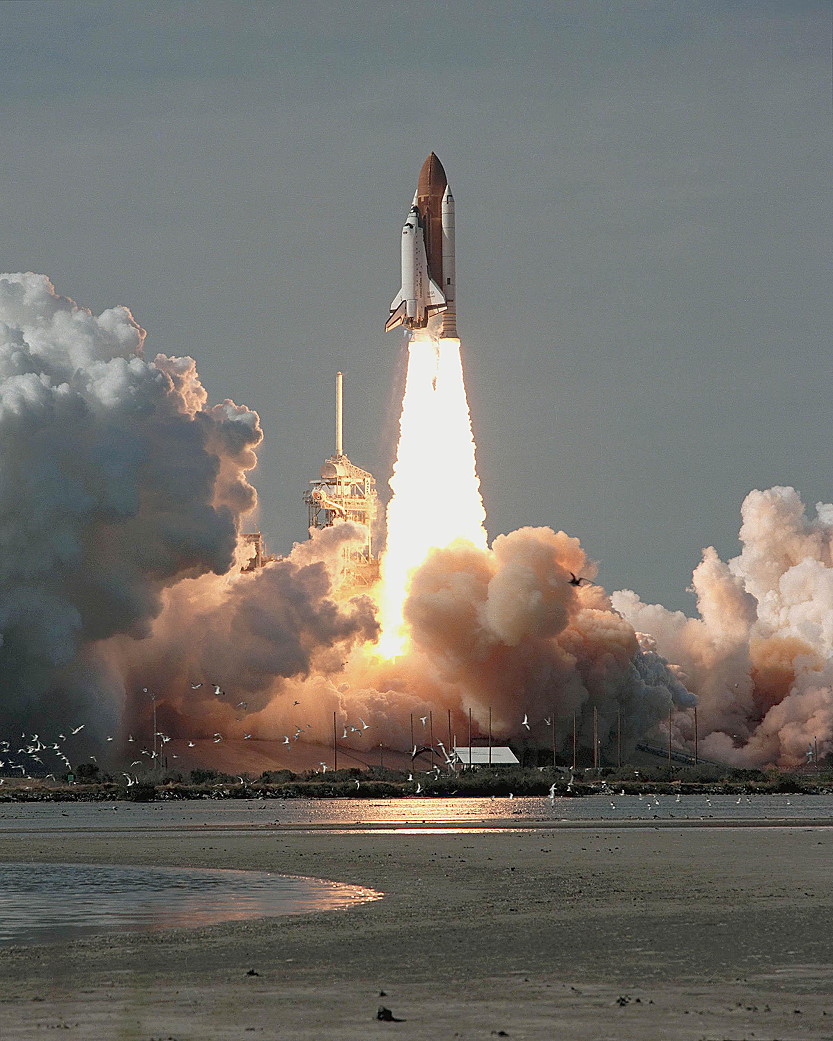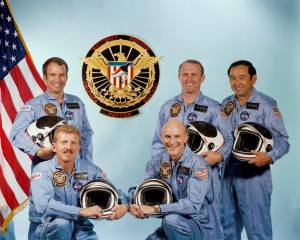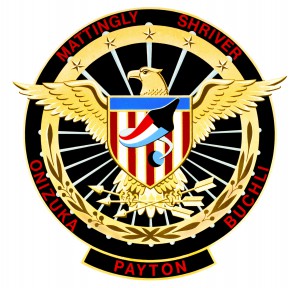
“Miracle” is a term which is often applied to many aspects of the space program: to Yuri Gagarin’s pioneering flight to the accomplishment of the first manned lunar landing or to the safe return of Apollo 13. But the launch of Space Shuttle Discovery on 24 January 1985—30 years ago, today—on Mission 51C marked a miracle of another kind. In a sense, it was quite literally miraculous that the orbiter made it into space at all … both metaphorically and literally, as the Challenger accident investigation would later reveal. When astronauts Ken Mattingly, Loren Shriver, Ellison Onizuka, and Jim Buchli were named as the crew of STS-10 in October 1982, they confidently expected to launch aboard Challenger in September of the following year on the first classified mission for the Department of Defense. It would put the shuttle’s advertised ability as a “truck” for the United States’ largest and most sensitive national security sentinels to the ultimate test.
Unfortunately, the mission quickly ran into problems when the Inertial Upper Stage (IUS) booster, built by Boeing for the U.S. Air Force, failed to properly inject the first Tracking and Data Relay Satellite (TDRS) into geostationary orbit in April 1983. Mattingly’s mission was manifested to use the same type of rocket stage. The flight hung in limbo whilst an investigation board pored over the failure and made recommendations, and Boeing spent a year correcting the problems and recertifying the booster. By November 1983, Mattingly’s flight had been redesignated as Mission 41E and rescheduled for July of the following year, but within a few months it was delayed yet again. When NASA issued an updated manifest in May 1984, it had vanished entirely and Mattingly’s crew were reassigned to 51C, still with Challenger and set for December. “That,” said Loren Shriver, “is when we started to learn that the numerical sequence of the numbers of the missions … didn’t mean a lot.”
For a time, Shriver wondered if he would ever fly, but unlike other missions, payloads were very much interchangeable; they were a Department of Defense crew. “You were kind of linked to it,” he recalled, “as long as there was some thought that it was going to happen, and it never did completely go away. It just went kind of inactive for a while, then came back as 51C.” When he was assigned to the mission, Shriver was unsurprised that the crew were all active-duty military officers. “I think NASA believed that it didn’t have to do that,” he recalled, “but I think it also believed that things would probably go a lot smoother if they did.” Flying a classified mission posed its own problems for Mattingly. Within NASA, he had become familiar with the practice of sharing information, particularly about the shuttle. With a Department of Defense payload, the crew could not publicly discuss the particulars of their flight, and the exact details were made available to only a handful of engineers, technicians, and Air Force managers. “I had some apprehension,” Mattingly said, “about could we keep the exchange of information timely and clear in this small community when everybody around us is telling anything they want and we’re keeping these secrets. Security was the challenge of the mission.”

Cipher locks were placed on training materials, “but then you had to give the code to a thousand people, so you could go to work!” They were given a classified meeting room in the astronaut office, a classified safe for their documents … and a classified phone, with an unlisted number. In the entire span of their training time together, the phone rang just once. It was a sales call, asking Mattingly if he wanted to buy a new long-distance service!
The ridiculous levels of secrecy became even more laughable at other times, particularly when the astronauts were obliged to “disguise” the places where they were doing their training. They would file T-38 flight plans to Denver, Colo., then file new ones to the San Francisco Bay area, then rent a car to eventually reach their military destination at Sunnyvale, Calif. They were asked to do their mission training during the daytime and at night, to keep the launch time secret from prying eyes, or anyone who could be bothered to put two and two together, but all this furore never convinced Mattingly that anyone really cared. On one occasion, their office secretary booked motel rooms for them—“secretly,” of course—but the four astronauts, crammed into a decrepit old rental car, with Ellison Onizuka at the wheel, had a surprise when they arrived. Jim Buchli spotted it first.
“Stop here,” he said. “Now, let’s go over this one more time. We made extra stops to make sure that we wouldn’t come here directly … and they can’t trace our flight plan. We didn’t tell our families. We didn’t tell anyone where we were. And we can’t tell anyone who we’re visiting. Look at that.” Four sets of eyes peered over toward their “secret” motel … and beheld an enormous banner, emblazoned with the legend: WELCOME, 51C ASTRONAUTS. “How’s that for security?” chuckled Mattingly.
When Challenger returned from her previous flight in October 1984, she was scheduled to be relaunched on 8 December for Mission 51C, but inspections revealed that almost 5,000 of the delicate thermal protection tiles had become debonded during re-entry. One tile, located in the vicinity of the left-hand wing chine, had completely separated from the airframe and, although not a catastrophic problem in itself, revealed a far more worrying issue. A vulcanizer material, known as “screed,” used to smooth metal surfaces under tile bonding materials, had softened to such an extent that its “holding” qualities were impaired. Subsequent investigation revealed that repeated injections of a tile waterproofing agent called “sylazane,” coupled with the effects of six high-temperature re-entries, had caused degradation in the bonding material. By the time Challenger flew her next mission, the use of sylazane had been scrapped. In the interim she was reassigned to Mission 51E, scheduled for launch in March 1985, and 51C switched to Discovery with a launch date in late January 1985. Years later, Loren Shriver did not remember any significant mission impact, other than the six-week launch delay from switching orbiters.

Due to the classified nature of the flight, some Air Force officials did not even want the precise launch date, or even the astronauts’ names, released to the public. Loren Shriver was not alone in his amazement at this excessive insistence on secrecy. “We weren’t going to be able to invite guests for the launch in the beginning,” he told the NASA oral historian. “This is your lifelong dream and ambition. You’re finally an astronaut and you’re going to go fly the shuttle and you can’t invite anybody to come watch …We finally got them talked into letting us invite … 30 people, and then maybe some car-pass guests, who could drive out on the causeway … but trying to decide who, among all of your relatives and your wife’s relatives, are going to be among the 30 who get to come see the launch, well, it’s a career-limiting kind of decision if you make the wrong decision. You have part of the family mad at you for the rest of your life!”
Fortunately, Shriver’s family and most of his wife’s relatives were from Iowa, which was sufficiently distant for many to be unable to make the journey to Florida. Privately, Shriver and his crewmates worried that their inability to discuss the mission openly might compromise their preparedness and the thoroughness of their training. It must have been an unusual sight to behold the 51C stack, sitting on Pad 39A, with only a select number of military and NASA personnel knowing precisely when the launch would take place; in fact, the media had been told to expect liftoff within a three-hour “block” of time, sometime between 1 p.m. and 4 p.m. EST on 23 January 1985. Freezing weather conditions kept Discovery on the ground that afternoon, but the situation seemed to have improved marginally by the following day.
For the spectators at the Kennedy Space Center (KSC), the famous countdown clock, which normally ticks away the final minutes and seconds, showed a blank face, and all communications between launch controllers and the flight crew were kept quiet.
Then, at 2:41 p.m. EST, the blackout suddenly ended with a statement from the launch commentator: ” … T-9 minutes and counting. The launch events are now being controlled by the ground launch sequencer … “
The spectators braced for the first shuttle launch of 1985.
The second part of this article will appear tomorrow.
Want to keep up-to-date with all things space? Be sure to “Like” AmericaSpace on Facebook and follow us on Twitter: @AmericaSpace




One Comment
One Ping
Pingback:‘Roger, Houston': Mission Control Center (MCC) Celebrates 50 Years of Spaceflight Operations Support « AmericaSpace